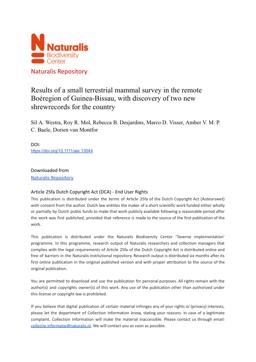2022-06-28
Results of a small terrestrial mammal survey in the remote Boé region of Guinea‐Bissau, with discovery of two new shrew records for the country
Publication
Publication
African Journal of Ecology , Volume 60 - Issue 4 p. 946- 957
The Boé region in the south-east of Guinea-Bissau has remained untouched by large-scale human influence and development due to its isolated location. The region consists mainly of savannah interspersed with gallery forests and hosts a unique and valuable biodiversity though very little is known of small terrestrial mammal diversity. In 2013, a terrestrial small mammal live trapping survey was conducted around Béli, a small village in the South of the Boé region. Five survey locations of three ecotypes were selected, and a combination of pitfall traps and live traps was used to capture and release small mammals. A selection of mammals that could not be identified as well as accidental mortalities in the traps were collected as voucher specimens and sent to Naturalis Biodiversity Center in the Netherlands. Over 96 survey days, a total of 331 small terrestrial mammals were trapped from 21 unique species, which include two new species records for the country: shrew species Crocidura lamottei and Crocidura crossei. Extrapolation from species accumulation curves suggested an overall species richness of 22 species for the region, with substantial differences in community composition among sampled habitats. The results of this study are an important part of the scientific record for small terrestrial mammals in the Boé region and set a baseline reference for future conservation efforts.
| Additional Metadata | |
|---|---|
| , , , , , , , | |
| doi.org/10.1111/aje.13044 | |
| African Journal of Ecology | |
| Organisation | Staff publications |
|
Westra, Sil A., Mol, Roy R., Desjardins, B., Visser, Marco D., Baele, Amber V. M. P. C., & van Montfort, Dorien. (2022). Results of a small terrestrial mammal survey in the remote Boé region of Guinea‐Bissau, with discovery of two new shrew records for the country. African Journal of Ecology, 60(4), 946–957. doi:10.1111/aje.13044 |
|
